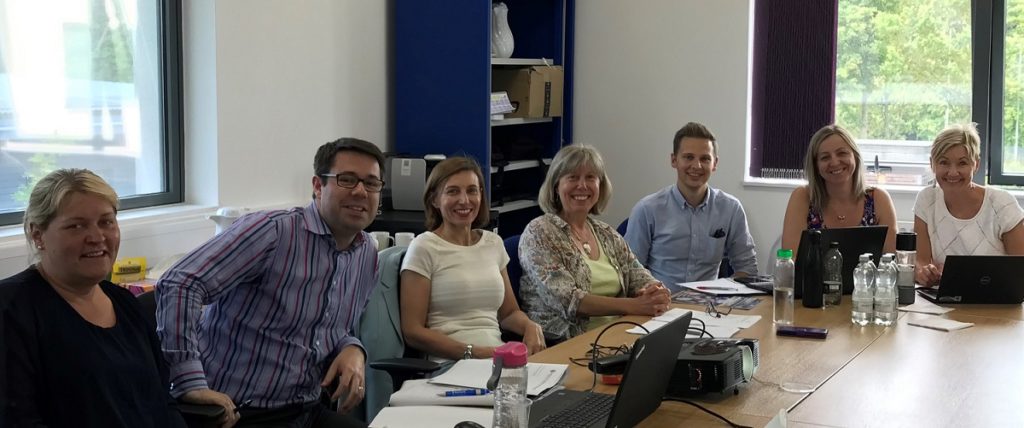Business tends to be more interested in output than input. Clients rarely ask how you put together the service you provide or how you acquired the skills for it. If the product delivered is fit for purpose and the customer experience more or less positive, the client is satisfied.
As soon as the quality of the output is brought into question, though, the focus turns to the input. Was the service provider qualified? Were they properly vetted? What processes were applied? How did they demonstrate their expertise? What tools and resources did they use? Suddenly, everyone is keen to understand the correlation between the quality of what goes in and the quality of what comes out.
I am a member of the Professional Development Committee (pictured below) of the Institute of Translation and Interpreting (ITI), a UK-based professional membership association for practising translators, interpreters and language services businesses.
For four years, I have worked with my volunteer peers to support the institute’s members in maintaining the highest possible standards within their profession. The committee contributes to this by devising an annual programme of training events and webinars, and by facilitating the record-keeping of members’ participation in these activities. In other words, it caters for continuing professional development (CPD) in the translation industry.


What is CPD?
It is hard to imagine that anyone in the modern workplace would still consider full-time education the sole training ground that prepares us for our careers.
However significant that initial learning period may be, it doesn’t take us all the way to specialisation. Nor does it equip us to cope with the fact that we end up changing careers three to four times over the course of our lives. And even if we don’t, the pace of change now makes most skills and technical knowledge in the workplace obsolete within five to ten years.
Sometimes continuing professional development is mandated by professional organisations or required by codes of ethics – this is the case in regulated fields such as medicine, engineering and law. But at its core, it is the personal responsibility of professionals to keep their knowledge and skills current so that they can deliver the high quality of service that meets the clients’ expectations and the requirements of their profession.
CPD activities can range from formal educational activities such as instructor-led training courses, workshops or seminars to more informal approaches such as work-based learning or mentoring. CPD can also include self-study such as e-learning courses and structured reading. It can be provided by commercial training companies, independent coaches and professional associations, or internally by colleagues and mentors.
CPD in the translation industry
What does continuing professional development look like in the global language industry? It should enable language professionals to keep up to date with new working methods and tools, and to specialise, diversify and stay abreast of the latest developments in their field of expertise.
The European Master’s in Translation, a partnership project between the European Commission and master’s level translation programmes at European higher education institutions, published their first translation competence framework in 2009. This reference standard for translator training defines fives areas of competence which can also be applied to translators’ life-long learning:
- Language and culture – This encompasses all the general or language-specific linguistic, sociolinguistic, cultural and transcultural skills that constitute the basis for advanced translation competence.
- Translation – This refers to the transfer of meaning between two languages. It includes the analysis of the source document, implementation of instructions, style guides and conventions, assessment of what is fit for purpose, and justification of solutions and choices.
- Technology – This consists of the skills required to use translation technology in the translation process, but also the use of any workflow management software, search engines, corpus-based tools and other standard office software.
- Personal and interpersonal – This includes all the “soft skills” from time and stress management to teamwork, from the use of virtual communication methods to ergonomics, and from self-assessment to collaborative learning.
- Service provision – This covers the skills related to the provision of language services in a professional context – from client awareness and negotiation through to project management, quality assurance and invoicing.
I would add to these a sixth competence: the domain expertise translation professionals need in order to understand the subject matter of the text they work with. In my experience, this is the competence clients are most interested in.
According to the ITI’s records, most of their members partake in training that focuses on language development and maintenance, translation skills or subject-specific knowledge. However, many are also seeking high-quality, applicable and quick training sessions on business and technical skills.
CPD opportunities for translators and translation project managers
The CPD training currently available for language industry professionals varies in quality and relevance.
Language technology developers organise training for their own products. Membership associations try to provide opportunities, but the content is ad hoc and difficult for them to curate when the contributors are volunteers who mainly share their personal experience. Many translation companies offer webinars, usually to their own freelancer pool, and often in connection with training their own in-house linguists.
All these CPD offerings lack external moderation and evaluation. For domain-specific expertise, translators have to seek training and learning within the industry verticals they work with.
For the members of the translation industry, continuing professional development may therefore call for persistence and even creativity, but above all it requires a critical approach, a bit of research and simple planning ahead.
Write a CPD plan
CPD is most useful when it is planned. List the main areas of your work, articulate your long-term aspirations, identify your goals for the next few years, define what you need to learn in order to achieve your goals and determine which specific activities will meet your needs. Consider your immediate career prospects and think beyond them to the limits of your ambition and ability.
Write a SWOT analysis. List the things you do well, where you need to improve, what new opportunities there are for you and what challenges you must face. And recognise where CPD fits in with other demands on your time.
Keep a CPD record
Once you engage in continuing professional development, keep a record of your efforts. CPD records must be managed in a format that can be easily extracted for presentation. The extracts should show when you did the training (date), how long you spent on it (hours), what exactly you did (description) and what you learned that you can apply to your work (learning outcomes).
The international translation services standard ISO 17100 paves the way for a systematic approach to recording CPD. It asks certified language service providers (LSPs) for assurance that everyone involved in their translation production process (project managers as well as freelance and in-house translators) undertakes CPD every year. It does not state how many hours of development are required – that is for each LSP to determine for their own staff and partners.
Ask for CPD evidence
Clients and employers should ask for translation professionals’ CPD records at least as often as they ask to see their CVs.
Translators are aware of their need for continuing professional development, and many are already structuring their CPD activities and keeping records. What is needed now is for clients to take an interest.
Checking on translation providers’ CPD efforts does not feature in the translation service requests for proposal, as far as I know. Nor is it part of translation companies’ vetting process for their freelance translators, let alone the hiring process for in-house linguists or translation project managers.
But it should be. The CV of a good, experienced freelance translator may not have changed much in the past ten years, but their CPD record for the past three years will speak volumes for their professional pride, how engaged they are with the industry and how proactive they would be as a collaboration partner.
So in the interest of the best possible output, let’s take notice of the translators’ input – and support them in their efforts.
Director’s Cut, Quality management, Supply chain, Translation industry




